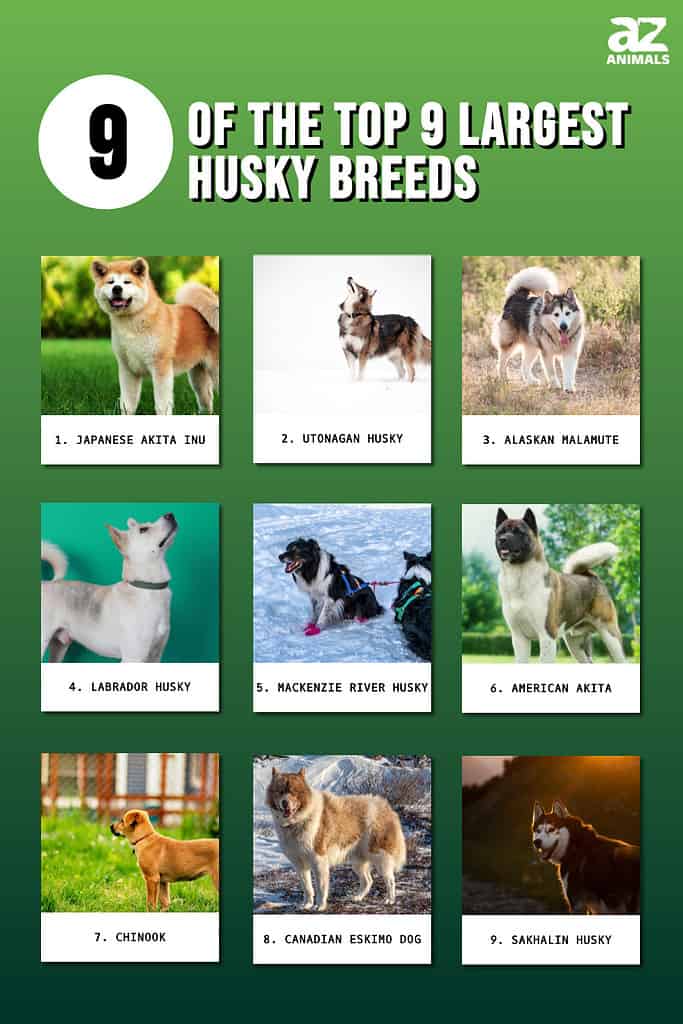
Huskies are generally large dog breeds. The dogs are powerfully built to suit pulling sleds. The species also have some genetic influence from wolves. Some were even bred to hunt large mammals.
Huskies were bred as working dogs to provide transport in cold climates. Depending on the breed, they are also a good companion and excel in sports, herding, hunting, and guarding. These breeds love going outside, but you should limit their exposure outdoors during summer.
The breed is a type of northern sled dog well-adapted to the Arctic’s freezing temperatures. Huskies have muscular and athletic bodies, thick double coats, and webbed paws for walking on snow. Due to their distant relationship to wolves, most husky types have a remarkable wolf-like appearance.
Large Huskies
Knowing a dog’s size, weight, and stamina are vital when adopting a puppy. Smaller husky breeds can suit owners with limited space, but large breeds need plenty of space and exercise. Huskies are working dogs; the larger their size, the more active they are. Denying your husky ample exercise is not good for the pup and will encourage unbecoming behaviors.
Large husky breeds with proper training are good pets, though we should always put them on leashes in public places, no matter how well-trained. Additionally, take caution if they behave aggressively toward small children and other smaller pets. Ensure you always supervise your young ones when playing with a furry friend. Additionally, spitzes are extraordinarily loyal, which can cause them to be overly protective of their family.
Let’s take a look at the top nine largest husky breeds!
1. Japanese Akita Inu (24– 28 Inches, 75- 120 Pounds)
Since the 1600s, akita inu’s descendants in Japan have a history of working in various jobs. Initially bred for hunting bears, they are also excellent guard dogs.
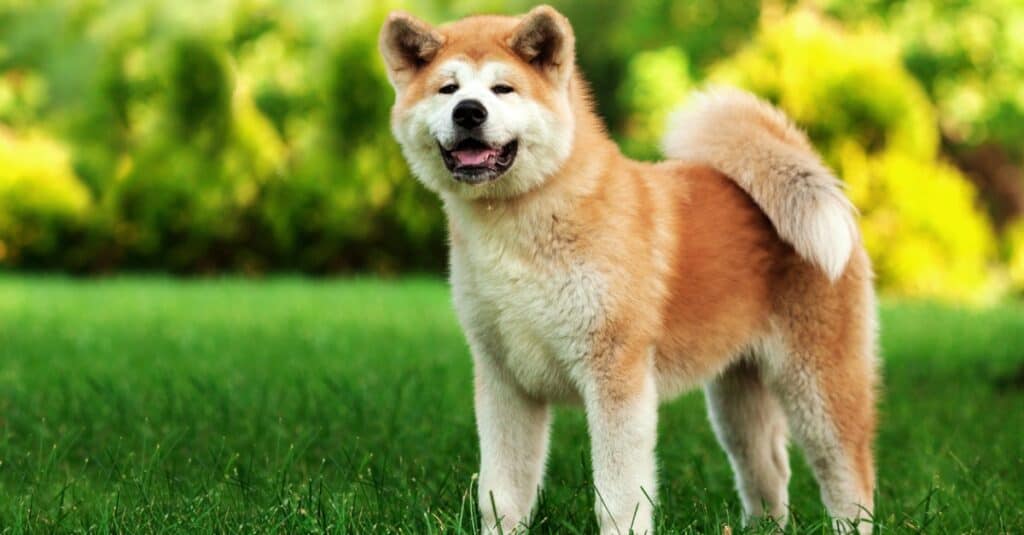
Akita inu is the largest husky weighing up to 120 pounds.
©TatyanaPanova/Shutterstock.com
Today, there aren’t many owners of the Japanese akita breed. These tall dogs can reach heights of 28 inches and maintain a healthy weight of 120 pounds. Northern dog breeds are independent and need an experienced owner. Also, you will need a large property when rearing the breed.
2. Utonagan Husky (30 Inches, 110 Pounds)
Like most husky types, the utonagan closely resembles a wolf. In fact, their name comes from the Chinook Indian word meaning ‘spirit of the wolf.’
Utonagan is not a pure breed but a mixture of Alaskan Malamute, Siberian husky, and German shepherd. They are a relatively young breed that was developed in the 1980s. The original breeder, Edwina Harrison, intended to create a friendly and easy-to-train dog that resembled a wolf.
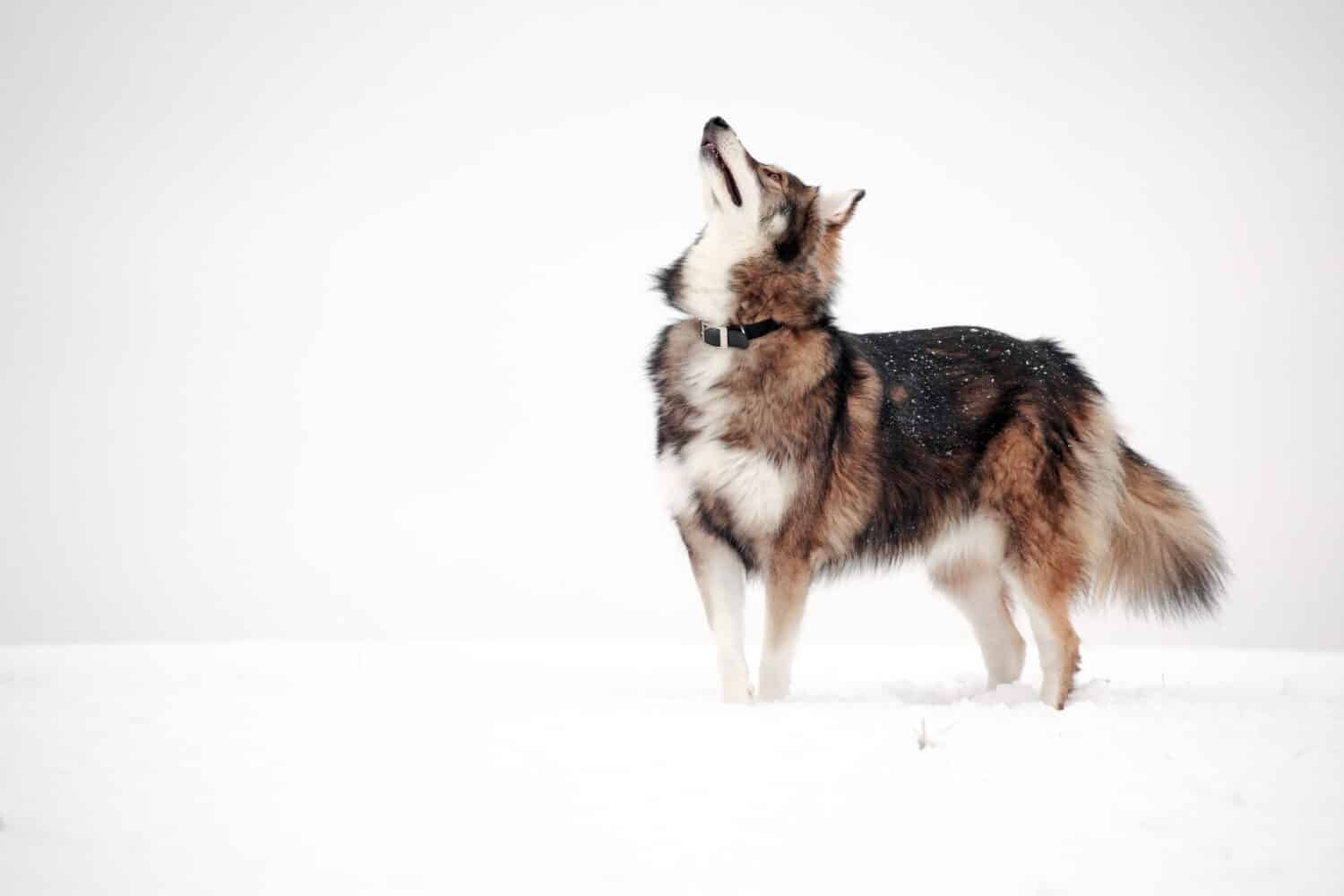
A utonagan husky weighs as much as 110 pounds.
©Binson Calfort/Shutterstock.com
Although the breed wasn’t meant to pull sleds or hunt, they have impressive stamina. The utonagan is taller than the Alaskan Malamute. They can reach heights of 30 inches and weigh as much as 110 pounds.
Unlike most huskies, the utonagan is naturally well-balanced and gentle. They adapt well to family life and enjoy the home environment. However, they are active dogs that need lots of exercise and space. These dogs also display the characteristic husky independence.
3. Alaskan Malamute (23-26 Inches, 75-100 Pounds)
Alaskan Malamutes are among the oldest husky breeds created by the Mahlemut tribe. They are direct descendants of wolves and have existed for over 2,000 years.
Malamutes excel in many tasks, including:
- Hunting game
- Pulling sleds
- Guarding
- Companionship
The wolf-like appearance of Alaskan Malamutes is believed to be a result of the Mahlemut tribe enforcing their female dogs to mate with wolves. The tribe tied female dogs to trees in the forest, attracting male wolves to mate. The resulting litters had more wolf genes.
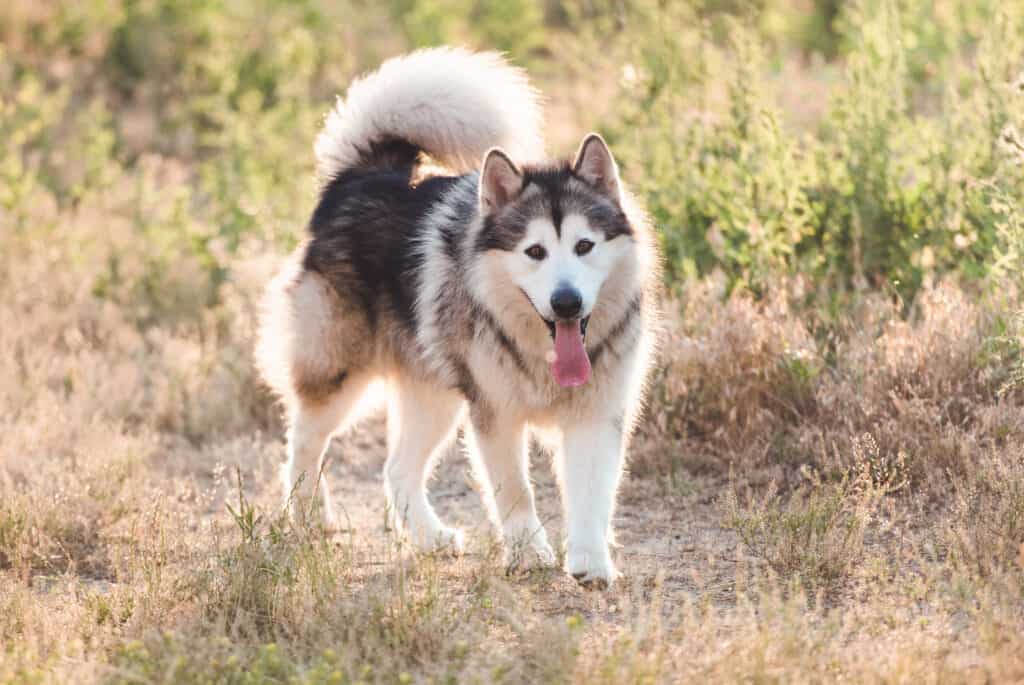
Alaskan Malamutes weigh about 100 pounds.
©iStock.com/VYCHEGZHANINA
They are cousins of the Siberian husky and resemble the husky to a certain extent, though these dogs are different breeds. American Kennel Club registered Alaskan Malamute as a breed in 1935. The breed’s males can attain a height of 23-26 inches and weigh as much as 100 pounds.
The Alaskan Malamute may not be a good companion for first-time pet owners. Additionally, space is critical to these dogs because they are very active. If you live in the countryside, this breed will thrive, running long distances and enjoying outdoor activities.
4. Labrador Husky (26 Inches, 100 Pounds)
Although many assume Labrador huskies are a cross between a retriever and a husky, they are not. Labrador huskies are a breed of their own. However, the dogs have some Alaskan Malamute and German shepherd heritage. This husky breed originates from the Labrador area in Canada, where they were introduced in 1300 A.D. by the Inuit people.
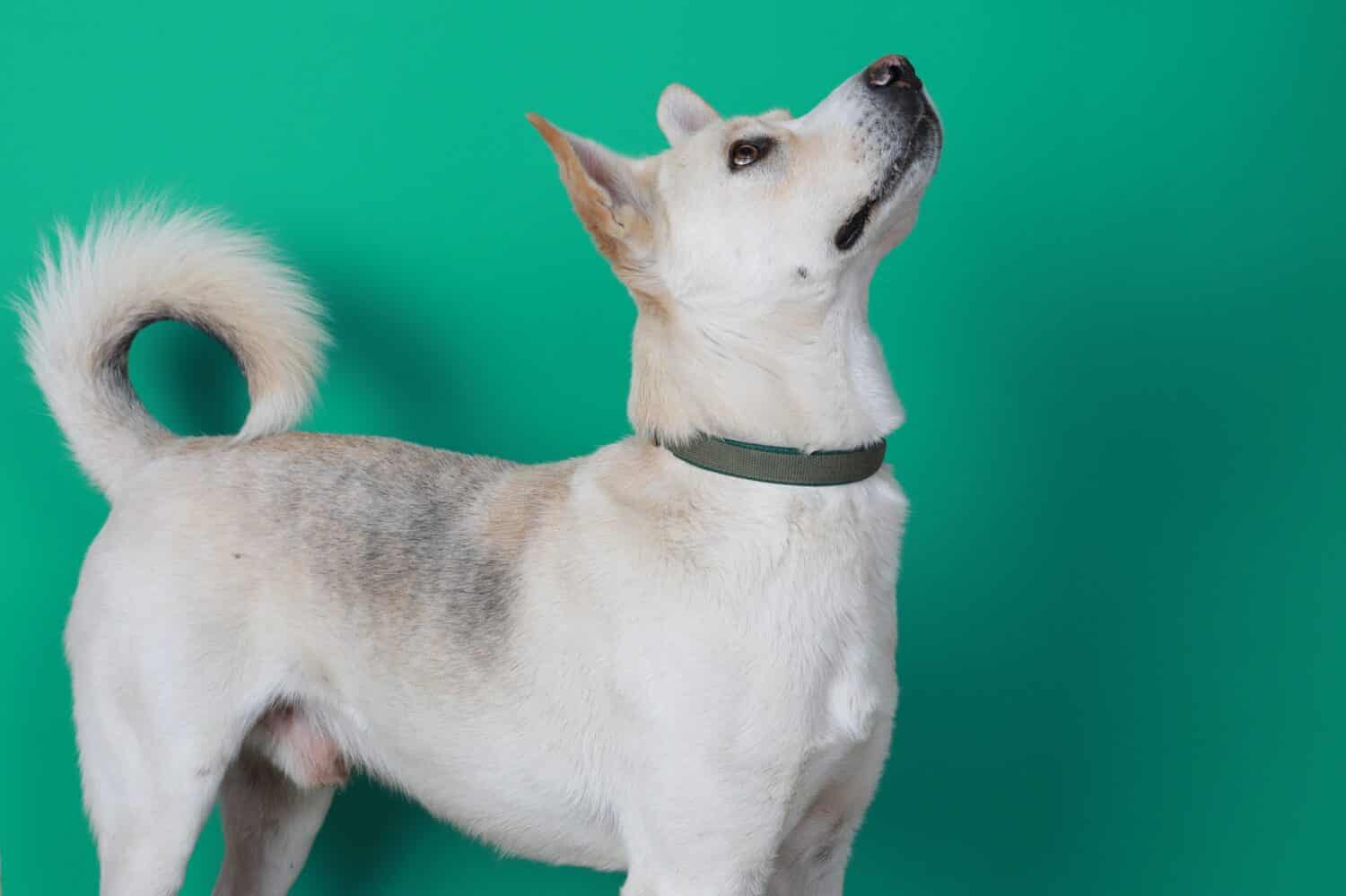
Labrador huskies weigh about 100 pounds.
©Bernard Khalil/Shutterstock.com
Labrador huskies have a similar temperament to Siberian huskies. They are affectionate and hardworking. This large breed can attain a height of 26 inches and weigh up to 100 pounds. They have a dense, wavy coat that comes in black, red, brown, gray, white, or even multicolored.
Due to their size and powerful hunting instinct, Labrador huskies aren’t suitable for homes with smaller pets. The dogs bond closely with their family and can become overly protective.
5. Mackenzie River Husky (27-32 Inches, 90 Pounds)
Due to confusion about the Mackenzie River breed, there are conflicting views on whether they are a breed or a type. Although they have a different build and coat from the famous Siberian cousin, AKC doesn’t recognize the breed.
In General, the breed name is used for several dogs from Northwestern Canada. They are sled dogs from the Yukon Territory, a crossbreed of European breeds like Newfoundland or St. Bernard. Mackenzie River huskies are rare and primarily restricted to their homeland.

The Mackenzie River husky weighs about 90 pounds.
©iStock.com/Alexandre Patchine
The Mackenzie River breed falls under the freight husky category, originating near the Arctic Circle. The breed type belongs to dogs that worked together in small teams, pulling heavy loads across rugged terrains of deep snow. Mackenzie River huskies are known for enduring serious work with minimum provisions.
The river husky is larger than the Siberian breed, reaching shoulder heights of 27-32 inches. They can have a healthy weight of up to 90 pounds. These dogs resemble wolves in their body structure, posture, and methods of bonding.
The Mackenzie River husky breed is independent and has a dominant spirit, which can be taxing for first-time owners.
6. American Akita (23-27 Inches, 50-90 Pounds)
The American akita is prevalent in North America. The breed is smaller than their Japanese cousin. They can attain a height of 23-27 inches and weigh between 50-90 pounds.
AKC recognizes American and Japanese akita as two separate strains of the same breed. However, breeders are pushing for the species to be put into a different, distinct category.

Akitas are good guard dogs.
©Kseniia Kolesnikova/Shutterstock.com
The dogs can be pretty dominant and tend to get into fights with other dogs. For these reasons, American akitas require intensive training. On the plus side, they are good guard dogs that will protect your property.
7. Chinook (22-26 Inches, 55-90 Pounds)
At a glance, Chinook differs from other husky species, but they are also sled dogs. Most huskies have a rich coat, facial markings, curled tails, and prick ears. However, the Chinook closely resembles a Labrador.
The dogs are large and can attain a height between 22 to 26 inches and weigh 55 to 90 pounds. The American Kennel Club recognized the breed in 2013. They are a rare breed, the 190th breed registered by AKC among the 197.
Chinooks are a 1900s breed, a cross between a mastiff and a husky. They originate from New Hampshire, and the state recognizes Chinook as its official state dog.
They are amiable dogs that interact well with humans and other animals. Training a Chinook demands experience and expertise, as these dogs can make independent decisions.
8. Canadian Eskimo Dog (22-28 Inches, 66-88 Pounds)
The Canadian Eskimo husky was bred to hunt polar bears and haul goods on sleds. The dogs are powerful and can pull as much as 176 pounds. However, currently, their numbers are critically low.
The main reason for their decline is the innovation of snowmobiles. The powered snow vessels have had a tremendous negative impact on the breed. Also, in the early 1970s, a government initiative to eradicate dogs due to safety and health concerns nearly wiped them off the planet.
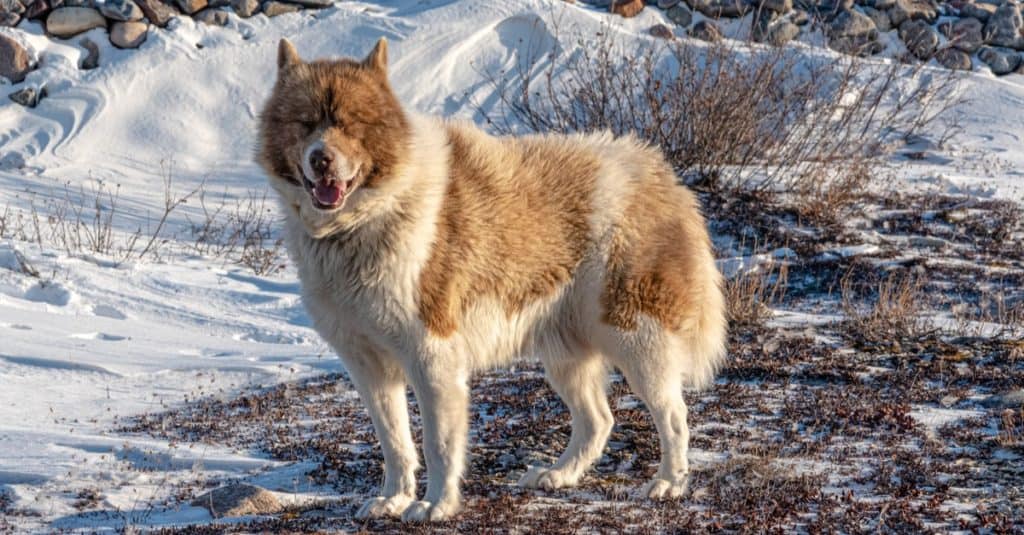
Canadian Eskimo are rare, with only 300 huskies registered by CKC.
©Scalia Media/Shutterstock.com
Thanks to recovery efforts, their numbers are increasing. Today, CKC records indicate there are 300 Canadian Eskimo huskies in existence.
The Exquimaux husky appearance is the same as that of the spitz. They have a robust build and an imposing look. They average between 22-28 inches in height and maintain a maximum healthy weight of 88 pounds.
According to CKC, the Canadian Eskimo husky is still primitive and can’t qualify as a house pet even though the dog is affectionate and can be a great furry friend for experienced pet owners. The breed needs lots of space and exercise and will not suit someone living in an apartment.
9. Sakhalin Husky (66-88 Pounds)
The Sakhalin husky (Karafuto Ken) is a rare Japanese sled dog near extinction. The species is a relatively large-sized husky breed, weighing 66 to 88 pounds. They have black, tan, and even cream markings. Sakhalin huskies are loyal, intelligent, active, and alert. Unfortunately, only a few Sakhalin breeders remain in Japan, and their numbers are unknown.
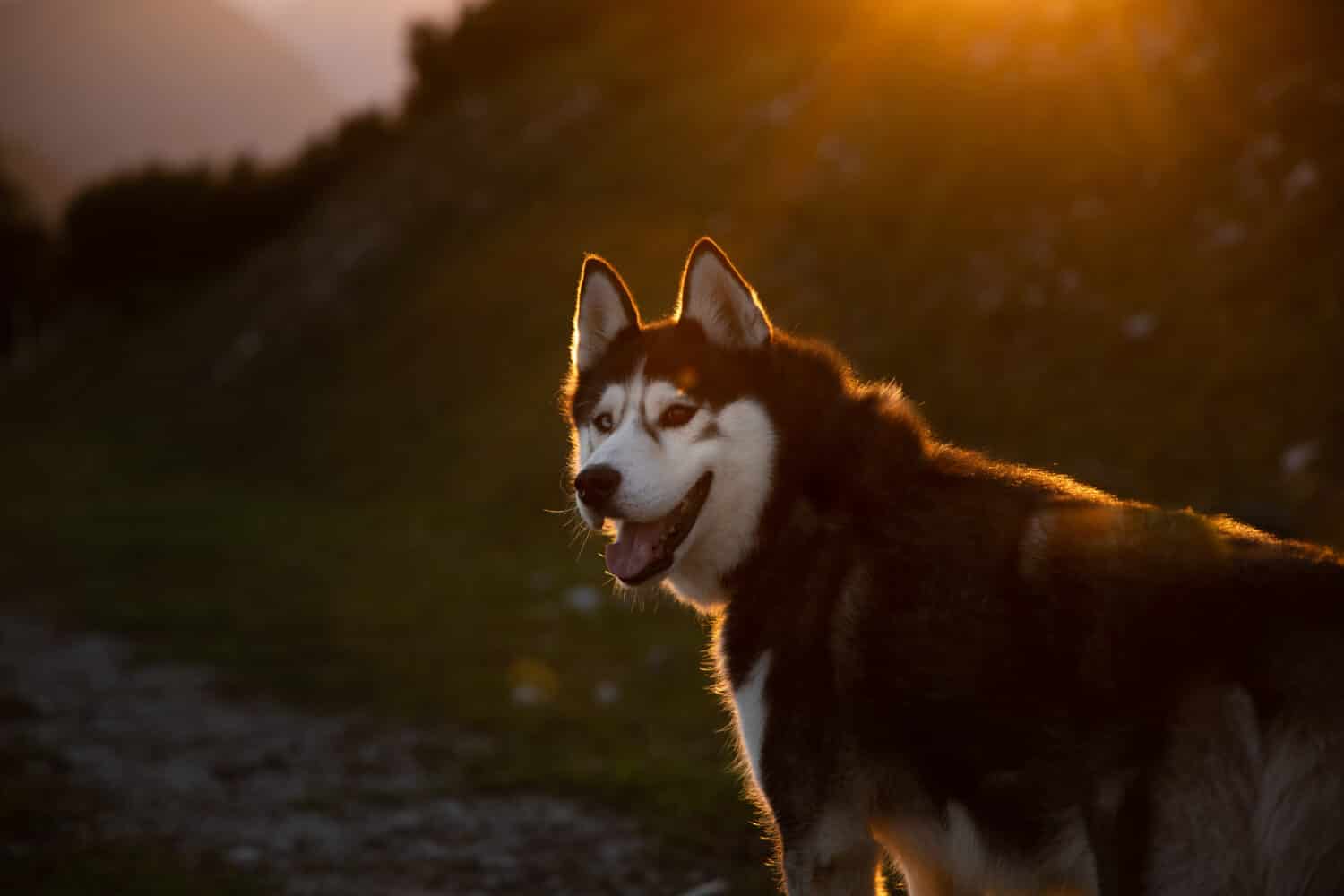
Sakhalin huskies weigh about 66-88 pounds.
©Wirestock Creators/Shutterstock.com
Sakhalin huskies hit the limelight during the 1958 rescue operation of researchers from Japan in Antarctica. Fifteen dogs accompanying the researchers were left behind to be rescued later. The dogs were left in a safe area with food and water.
However, a storm halted the rescue efforts, and many believed the dogs were dead. After one year, a new expedition arriving in the location found two miraculously surviving Sakhalin huskies from the team left behind.
How Large is the Common Siberian Husky?
Siberian huskies are the most familiar type of husky and the “original huskies breed.” They are medium-sized dogs reaching a height of 20-23 inches and weighing between 35-36 pounds.
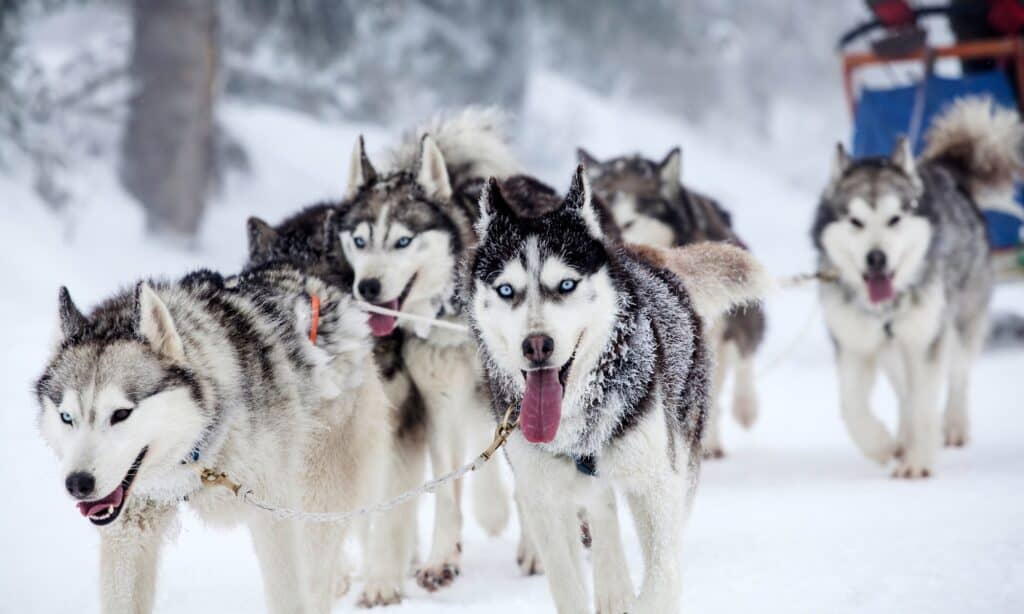
Siberian huskies excelled in the Search and Rescue Unit of the U.S. Army during World War II.
©iStock.com/8213erika
They were bred to be sled dogs as they have outstanding endurance and are great athletes. Huskies are mostly known for pulling sleds and excelling in races. However, Siberian huskies also excelled in the Search and Rescue Unit of the U.S. Army during World War II in the Arctic.
The Chukchi’s Siberian huskies are hyperactive dogs that can challenge new dog owners. The dogs love running, escaping, and howling. Sometimes, they can even run away from home.
A Summary of the Largest Husky Breeds
| Number | Husky Type | Height (Inches) | Weight (Pounds) |
|---|---|---|---|
| #1 | Japanese Akita Inu | 28 | 120 |
| #2 | Utonaga | 30 | 110 |
| #3 | Alaskan Malamute | 26 | 100 |
| #4 | Labrador Husky | 28 | 100 |
| #5 | Mackenzie River Husky | 32 | 90 |
| #6 | American Akita | 27 | 90 |
| #7 | Chinook | 26 | 90 |
| #8 | Canadian Eskimo Dog | 28 | 88 |
| #9 | Sakhalin Husky | 20 | 88 |
The photo featured at the top of this post is © Gregory Simpson/Shutterstock.com
Ready to discover the top 10 cutest dog breeds in the entire world?
How about the fastest dogs, the largest dogs and those that are -- quite frankly -- just the kindest dogs on the planet? Each day, AZ Animals sends out lists just like this to our thousands of email subscribers. And the best part? It's FREE. Join today by entering your email below.
Thank you for reading! Have some feedback for us? Contact the AZ Animals editorial team.







